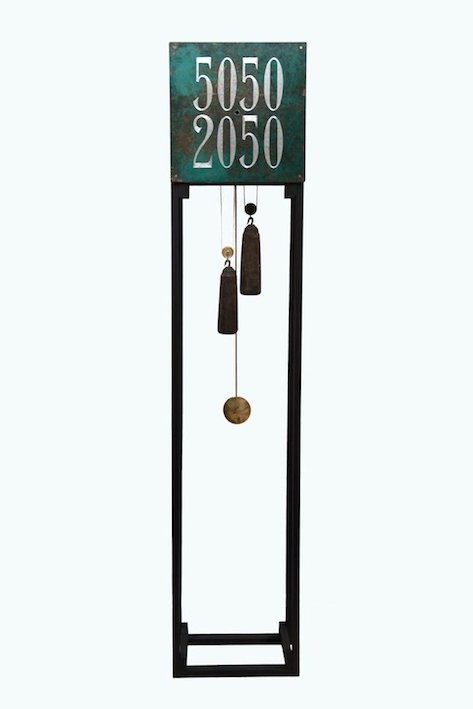ARTWORK DETAILS
David Aston
The 5050 by 2050 timepiece
Hand engraved patinated steel, mid-19th century brass clock movement and painted wood
228 H x 47.5 W x 32 D cm
2020







“The large timepiece is therefore a large diachronic timepiece. Unlike other clocks, its function is not to tell you the current time, but to encourages you to consider the future. To reflect on the findings of this research. The probability, the proximity of the date, but perhaps more importantly, the societal implications of such a future prediction. A prediction, if even remotely accurate, will see us living alongside equivalent human level intelligence within a generation.”
FURTHER DETAILS
Artificial Intelligence - The Oxford Dictionary defines Artificial Intelligence (AI) as “the theory and development of computer systems able to perform tasks normally requiring human intelligence, such as visual perception, speech recognition, decision-making, and translation between languages”. It is not surprising then that one of the key debates amongst futurists, scientists and philosophers at the centre of the research into the development and future of AI, is when AI will ultimately reach human-level intelligence, often referred to as general AI.
Since it’s conception in 1956 a number of surveys have been conducted in pursuit of this question and in order to understand the progress and outlook for AI. One of the latest survey of expert opinion, conducted by the Future of Humanity Institute at Oxford (Future Progress in Artificial Intelligence: A Survey of Expert Opinion) [1] polled 550 experts for their latest thoughts on the development of what they described as “high-level machine intelligence” or HLMI. The research defined HLMI as “one that can carry out most human professions at least as well as a typical human.”
Experts were asked “assuming no global catastrophe halts progress, by what year would you assign a 10% / 50% / 90% chance of the development of HLMI?” The results revealed a view amongst the selected experts “that AI systems will probably (over 50%) reach overall human ability by 2040-50, and very likely (with 90% probability) by 2075.”
The report is clear on the limitations and bias of such research and states an aim to “gauge the perception” and not to secure “well-founded predictions”. Nonetheless, these high probability data points suggesting that we may be living with human-level machine intelligence within 30 years and a high probability of super intelligence 30 years after that, is profound and inspired Oracle and the 50:50 by 2050 series.
The 5050 by 2050 large timepiece is a multi-media sculptural timepiece. A large contemporary clock face, antique clockwork movement, pendulum and weights suspended inside a oversized (228cm, 7ft 6 in) wooden frame in the abstracted form of a grandfather clock.
The clock face has been hand-engraved with the numbers 5050 over 2050 on a repurposed quarter inch thick circa 50 x 50 cm patinated steel square. The face has been drilled to accommodate a mid-19th century donor clock with elaborately crafted hands, dials and brass clockwork movement. The hands have been removed but the working mechanism, driven by weights and pendulum, continue to mark the minutes, hours and days. The minutes recorded by the ticking of the movement, the hours by the striking of the gong, and every eight days marked by the rewinding of the clockwork mechanism.
The kinetic timepiece is suspended within a frame in the outline of a grandfather clock. The frame is over-sized so that the clock dial has to be viewed from below and the movement can be seen and experienced in the round, encouraging the viewer to look up and contemplate the meaning behind the clock face and experience the noises of the movement and swing of the pendulum as it marks the passing of time towards the realisation of the future prediction.
By covering the original elaborately painted clock face and functioning minute, hours and date indicators, the original form and function of the timepiece has been altered. No longer able to read the time or date, the viewer is asked to contemplate the meaning of the two fixed sets of numbers engraved on the dial. 50:50 - signifying probability, the odds of one of two potential outcomes, in this case HLMI, and 2050, the predicted date by which the 2014 experts believe with 50% probability that HLMI will be achieved.
While the viewer contemplates the probability and impact of this future prediction, the antique clock movement continues to rotate and audibly mark the seconds, minutes, hours and days towards 2050 and the revaluation of this future prediction. For there is no more appropriate marker of time than an antique clock with a tick tock and a chime.
The large timepiece is therefore a large diachronic timepiece. Unlike other clocks, its function is not to tell you the current time, but to encourages you to consider the future. To reflect on the findings of this research. The probability, the proximity of the date, but perhaps more importantly, the societal implications of such a future prediction. A prediction, if even remotely accurate, will see us living alongside equivalent human level intelligence within a generation.
EXHIBITIONS
2023 - Whitechapel Gallery - East London Art Prize takeover
David Aston and researcher at the Future of Humanity Institute Anders Sandberg in conversation on the intersection of art and artificial intelligence (AI).
Link to Whitechaple Gallery.
2022 - York Art Gallery - Aesthetica Art Prize
https://aestheticamagazine.com/profile/david-aston-2/
PUBLICATIONS
Aesthetica Art Prize Anthology: Future Now
https://shop.aestheticamagazine.com/collections/future-now-collection/products/future-now-2022
TALKS & EDUCATION
2023 | Whitechapel Gallery | East London Art Prize x Whitechapel Gallery | In conversation with Anders Sandberg on the intersection of art & AI | Whitechapel Gallery | London: https://www.whitechapelgallery.org/events/east-london-art-prize-x-whitechapel-gallery/
